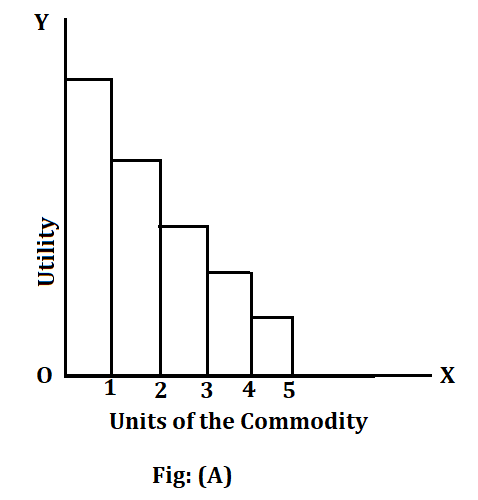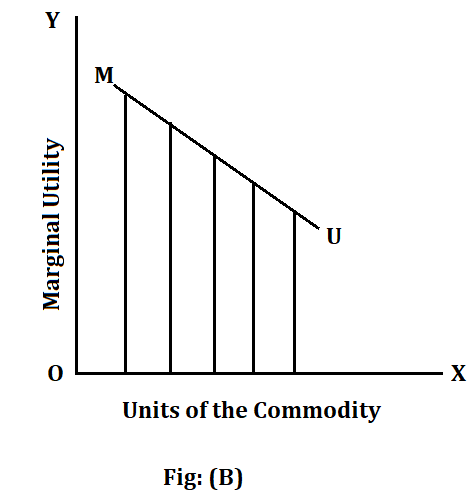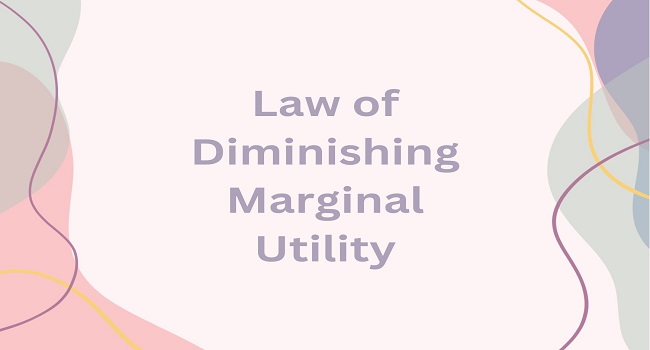Table of Contents
Law of Diminishing Marginal Utility:
This law can be traced back to the writings of Gossen and Bentham. It was, however, William Stanley Jevons who for the first time projected its bearing on the determination of value. According to this law, as a person purchases more and more units of a commodity, its marginal utility declines. In the words of Prof. Boulding, “As a consumer increases the consumption of any one commodity, keeping constant the consumption of all other commodities, the marginal utility of the variable commodity must eventually decline.” The law points out that the marginal utility of a commodity depends upon its quantity, but is not proportional to its quantity. The marginal utility of the commodity to the consumer depends upon the volume of the stock of the commodity purchased or possessed by him. The larger the stock purchased or possessed by him, the smaller is the utility derived from an additional unit of the commodity. The law can be formally stated thus, “As the quantity of a commodity possessed by a person at anytime increases, its marginal utility to him diminishes.”
It should, however, be remembered that the law of diminishing marginal utility says nothing about the rate of decline of marginal utility. It does not specify whether the marginal utility diminishes at a slow or a fast rate or whether it declines at a uniform or a variable rate.
The law of diminishing marginal utility can also be expressed in another way. When the consumer has only a little of a particular commodity, he puts it to the most urgent use. As he gets more and more of it, he begins putting it to less and less urgent uses. In the words of Baumol, this is so” because we give priority to more highly valued uses- if we have only one piece of cake, we give it to our child; if we have two, we give the second to our wife, as third we keep for ourself and a fourth we give to our mother-in-law.”
It should be clearly noted that when a person buys more and more units of a commodity or puts it to less and less urgent uses, the marginal utility derived therefrom has to diminish. It cannot, for example, increase. If the marginal unity were to increase with purchases of additional units of the commodity, then the consumer would spend his entire income on that commodity. As he purchases the first unit, it implies that the utility of the first unit is higher than its price. Now suppose that the marginal utility increases as he purchases more and more units of the commodity. In other words, the utility of an additional unit is higher than the utility of the preceding unit. As the utility of the first unit is higher than the price, the utility of the second unit will be still higher. So he will purchase the second unit. The utility of the third unit would be higher than that of the second unit. Therefore, he will purchase the third unit as well. In this way, once he starts purchasing the commodity, he would continue purchasing additional units of it till his entire income is spent on that commodity.
The fact that a person does not spend his entire income on one commodity or that he purchases several other commodities as well proves that the marginal utility does not increase as the quantity of a commodity purchased by him increases. Nor does the marginal utility remain constant with additional purchases of the commodity. If the marginal utility were to remain constant as the person concerned purchased more and more units of the community, his reaction would be similar to the one discussed above, i.e., he would spend his entire income on the purchase of that commodity. The utility of the first unit is greater than the price and hence, he purchases it. In other words, he enjoys a surplus of utility from the first unit. As the marginal utility remains constant, the utility of every additional unit will be higher than the price. The surplus of utility available from the first unit would continue to accrue from the succeeding units as well. Thus in this case as well, the purchaser would end up by spending his entire income on one commodity. This is contrary to our experience. We do not spend our entire income on one commodity. The conclusion, then, is that the margin utility neither increases nor remains constant with additional purchases of the commodity. On the contrary, it diminishes with every increase in the stock of the commodity.
Diagrammatic Representation of the Law:
The law of diminishing utility can be depicted by space as well as curve representation. In space representation, the utility of each unit of the commodity is shown by the area of the rectangle. The base of the rectangle is equal in all cases. This is shown in diagram (A).

The rectangles represent the utilities of the various units of the commodity. The first rectangle represents the largest area because the utility of the first unit is the maximum. But the areas of the successive rectangles go on diminishing in accordance with the operation of the law.
If the base of the rectangles is gradually narrowed down, each rectangle would assume the shape of a straight line. The length of the straight line would represent marginal utility in each case. If we draw a line to join the upper ends of all these straight lines, we will get what is known as a marginal utility curve. This is shown in diagram (B).

in this diagram, MU represents the marginal utility curve. This curve slopes downward to the right. because with every increase in the quantity of the commodity consumed, the marginal utility decline.
Assumptions of the Law:
The law of diminishing marginal utility is based on three important assumptions:
- the tastes of the consumer remain unchanged during the process of consumption.
- the units of the commodity are homogeneous, i.e., they are alike in size and quality.
- there is no time gap between the conception of the two units of the commodity. In other words, the process of consumption should be continuous without any time interval.
Any change in the above assumption would obstruct the operation of the law.
Exceptions to the Law of Diminishing Marginal Utility:
The following three cases are projected as exceptions to the law:
(1) It is pointed out that the consumption of liquor is not subject to the law of diminishing marginal utility. The more a person drinks liquor, the more he likes it. In other words, it is said that the marginal utility of liquor instead of diminishing actually rises with increased consumption. But careful consideration will show that after a certain stage, even the marginal utility of liquor to the drunkard will start declining and ultimately become negative. If that were not so, the drunkard will continue to drink for an indefinite period.
(2) It is pointed out that the law of diminishing marginal utility does not apply to money. The more money a person has, the greater is his desire to acquire still more of it. This is particularly true in the case of a miser. But even the miser is subject to the operation of the law in the long run. The fact that the miser spends some part of the income, however, small it may be, on food instead of spending all of it for acquiring additional wealth demonstrates that the utility to him of food is greater than that of money, which he spent on buying food. Thus, even a born miser, unless he happens to be a pathological case, is subject to the working of the law.
(3) It is pointed out that such hobbies. as a collection of stamps, old paintings, coins, old glass, and so forth offer an exception to the law of diminishing marginal utility. The greater the collection of a person, the greater is his desire to acquire additional units of these commodities. But careful consideration will show that a person does not spend increasing amounts of money in acquiring the same type of stamps or coins but new units of these commodities which he does not have in his possession. Thus even these hobbies are not exempt from the operation of this law.
Thus the so-called exceptions of the law are, in reality, no exceptions, and the law may be said to be of universal application in all cases of consumption.
Importance of the Law of Diminishing Marginal Utility:
The law of diminishing marginal utility is one of the basic laws of economics. It provides the foundation for various laws of consumption. For example, an important law of consumption, namely, th law of demand has been directly based on the law of diminishing marginal utility. The law of demand states that larger quantities of a commodity would be bought at a lower price than at a higher price. Why is it so? The reason is that as more and more units of a commodity are purchased, its marginal utility to the consumer grows less and less and he progressively gives smaller importance to additional units of the commodity. He will, therefore, buy additional units of the commodity only at a lower price. The law of demand is thus rooted in the law of diminishing marginal utility.
Why does the Law of Diminishing Marginal Utility Operate?
There are two reasons for the operation of the law:
(1) Commodities are not Perfect Substitutes- The first reason is that commodities are not perfect substitutes of each other. They are, at best, only imperfect substitutes. Had the perfect substitutability of goods existed, the law of diminishing utility would not have operated. For example, bread and butter are not perfect substitutes of each other. They tend to be consumed in certain appropriate proportions. The consumer secures maximum satisfaction only if these appropriate proportions are maintained. In case, these proportions are disturbed, the consumer shall cease to get maximum satisfaction from his consumption of the two commodities. If the consumer goes on increasing his quantity of butter with a constant supply of bread, very soon he will reach the stage when he shall not have enough bread to spread his butter on. Successive increments of butter wood add less and less to his total enjoyment, and the law of diminishing utility would come into operation. Had bread and butter been perfect substitutes of each other, the law would not have set in because in that case, the definition of bread could have been made up with the successive increments of butter.
(2) Satiability of Particular Wants- The second reason for the operation of the law of diminishing utility is that, although all the wants of a man cannot be satisfied, one particular want is satiable. For example, a person’s desire for salt can be fully satisfied if he consumes increasing quantities of this commodity. The point of satiety in the consumption of salt is this point where his total utility cannot be increased by further consumption and therefore the marginal utility is zero. If he were to reduce his consumption of salt, his total utility would increase and marginal utility become positive. This shows that between a level of consumption of salt, where the marginal utility is positive, and a high level where it is zero, the marginal utility must have been declining. The law would not operate if one particular want were not satiable.









Comments (No)